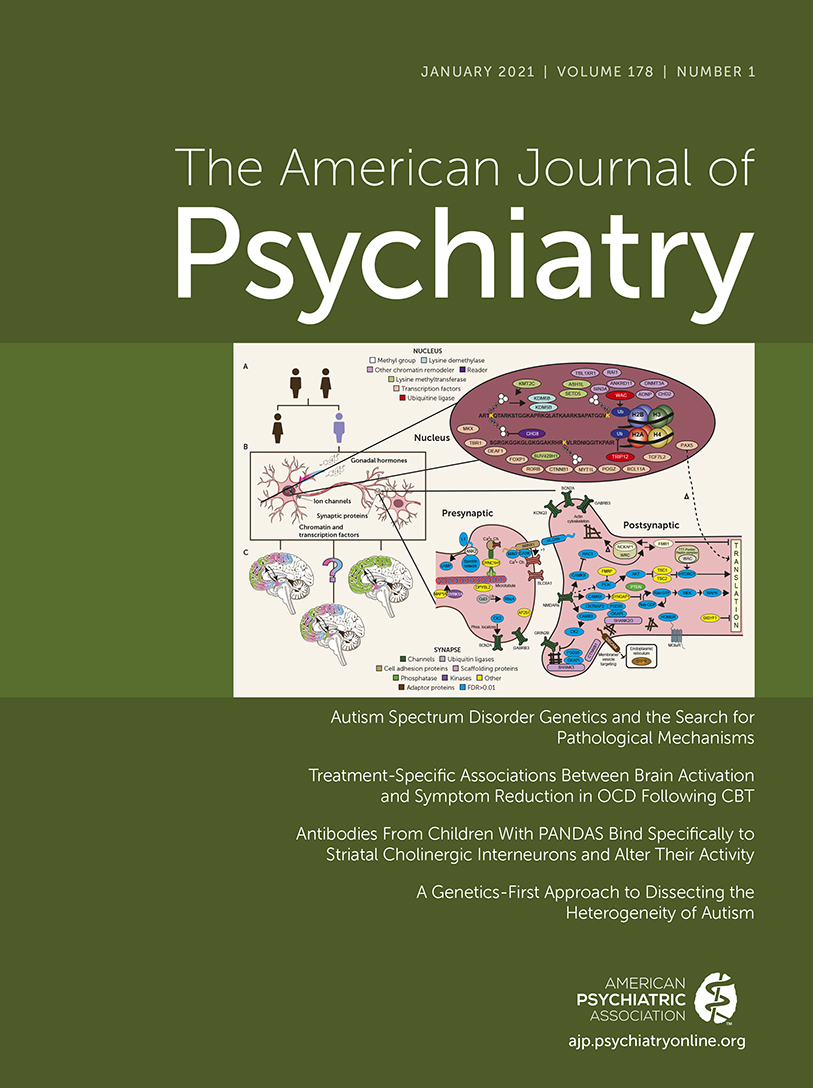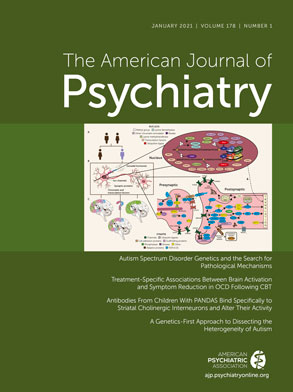A subset of children and adolescents with obsessive-compulsive disorder (OCD) have extremely rapid onsets, some occurring over the course of a day. Swedo et al. (
1) described 50 rapid-onset cases that were temporally closely associated with group A β-hemolytic streptococcal pharyngitis. The association of neuropsychiatric symptoms with group A β-hemolytic strep infections was precedented by Sydenham’s chorea, a frequent manifestation of rheumatic fever. Rheumatic fever is an inflammatory condition that results from prolonged strep infections (and thus was far more common in the preantibiotic era); it is characterized by fever, rash, arthritis, and carditis, and often, Sydenham’s chorea—rapid jerking movements typically of the hands, feet, and face. Notably, patients with Sydenham’s chorea are reported to have a high prevalence of co-occurring obsessive-compulsive symptoms (
2,
3). Sydenham’s chorea is thought to result from molecular mimicry in which antibodies directed against group A β-hemolytic strep bind to epitopes within the basal ganglia (
4), a brain region involved not only in movement disorders, but very likely also in OCD (
5).
Taken together, these observations suggested the possibility that autoantibodies affecting the basal ganglia could be responsible for strep-associated obsessive-compulsive symptoms not only when associated with rheumatic fever, but also in its absence. Swedo et al. (
1) described this syndrome as pediatric autoimmune neuropsychiatric disorders associated with streptococcal infections (PANDAS). However, the status of PANDAS as a diagnostic entity has remained controversial for want of more robust natural-history studies associating group A β-hemolytic strep infection with OCD and more convincing evidence for an autoimmune mechanism. In this issue of the
Journal, Xu et al. (
6) advance the argument for the validity of PANDAS by reporting that IgG antibodies from the serum of children who meet criteria for PANDAS bind to cholinergic interneurons (CINs) but not to other interneuron cell types within the striatum (a component of the basal ganglia). CINs, which utilize acetylcholine as a neurotransmitter, are implicated in the regulation of habit learning in animal models (
7), making them a plausible substrate for compulsive behaviors. The authors had previously shown that targeted ablation of CINs in mouse striatum results in tic-like stereotypies (
8), but it must be recognized that diverse genetic and pharmacologic manipulations of the basal ganglia have been shown to produce OCD-like symptoms (
9).
Evidence that would favor the molecular mimicry hypothesis of PANDAS pathogenesis includes 1) better documentation of a reliable temporal relationship between group A β-hemolytic strep infections and new or recurrent symptoms of OCD and 2) replicable evidence that antibodies against group A β-hemolytic strep cross the blood-brain barrier and bind to identifiable striatal epitopes (in human brain tissue). Ultimately, the interaction of the autoantibody with striatal targets should be shown to alter circuit function in a manner that produces obsessive-compulsive-like symptoms (research that requires animal models). A useful example comes from the investigation of anti-NMDA receptor antibodies. These autoantibodies often arise in response to teratomas (not infectious agents), can be reliably measured in cerebrospinal fluid, and produce psychosis, seizures, and other neurologic symptoms (
10).
One approach to investigating the relationship between streptococcal pharyngitis and obsessive-compulsive symptoms has been to prospectively follow two groups of children and adolescents with OCD—those whose initial presentation met criteria for PANDAS and those whose did not. Two such studies (
11,
12) have examined the temporal association between new group A β-hemolytic strep pharyngitis (laboratory validated) and exacerbation or recurrence of obsessive-compulsive symptoms or tics. While one of these prospective studies (
11) found a few more strep-OCD temporal associations than expected by chance, these represented only five of 64 exacerbations. Together these two prospective case-control studies did not find a significant temporal association between group A β-hemolytic strep infections and exacerbation of obsessive-compulsive symptoms in patients diagnosed with PANDAS. A complementary approach has been administration of antibiotic prophylaxis against recurrent strep infections in PANDAS patients with the goal of preventing exacerbations of OCD symptoms. Clinical trials to date have yielded inconsistent results (
13).
Studies of immune system involvement have been both laboratory-based and clinical. Antibodies from sera of patients with Sydenham’s chorea or with PANDAS have been reported to bind to diverse molecular targets on different cell types in rodent striatum or in human postmortem striatal tissue (e.g.,
14,
15). However, no replicable pattern of antibody binding has emerged. Moreover, binding of serum autoantibodies has reportedly failed to distinguish PANDAS or Tourette’s syndrome patients from control subjects (
16,
17).
Despite the pitfalls of inferring diagnosis from treatment response in psychiatry given, inter alia, the etiological heterogeneity of psychiatric disorders, several investigators have attempted to adduce evidence for immune mechanisms from the effects of immune modulatory treatments on PANDAS patients. The most studied such interventions are administration of intravenous immunoglobulin (IVIG) and plasmapheresis. Again, reported results are inconsistent in the small number of well-designed clinical trials that have been published (
13).
Against this challenging background, Xu et al. (
6) endeavor to demonstrate an immunologic mechanism for PANDAS. Their study design is complex, perhaps necessitated by a paucity of rigorously diagnosed PANDAS patients in research settings. In any case, they report on the binding and functional effects of serum immunoglobulins (IgG) from three separate cohorts of PANDAS patients and control subjects. Results from cohort 1 were previously reported (
18), with replication data and new assay results reported in this new study. The sera from patients in cohort 1 (five PANDAS patients and five control subjects) and cohort 2 (six PANDAS patients and six control subjects) were obtained from a previously conducted randomized, double-blind, placebo-controlled trial of IVIG where the primary outcome measures were improvement on the Children’s Yale-Brown Obsessive Compulsive Scale (CY-BOCS) and the Clinical Global Impressions improvement scale (
19). The trial did not achieve its primary endpoint during its double-blind phase. Nonresponders during the double-blind phase were offered open-label IVIG after week 6 and showed robust improvement; however, in the absence of blinding and a placebo control, this result cannot be interpreted to indicate a mechanism-based response to IVIG. The third cohort of PANDAS patients (N=16) and control subjects (N=12) had not been enrolled in the clinical trial but were seen in the same clinic from which the patients in the clinical trial had been drawn. To complicate matters further, the patients whose sera were included in cohorts 1 and 2 were selected for a positive response to IVIG in either the double-blind or open-label phase of the clinical trial, whereas the patients in cohort 3 were not selected by treatment response—indeed, some did not receive IVIG.
IgG from the PANDAS patients in each of the three cohorts showed higher average binding to CINs than IgG from the control subjects, albeit with overlap in levels of binding between the patient and control groups. Assays were performed by immunohistochemistry in mouse brain and in postmortem human striatal tissue. Binding of IgG to other types of striatal neurons was also examined. No average difference in IgG binding from PANDAS patients and control subjects was observed, consistent with selective targeting of CINs. An ex vivo assay performed on mouse brain slices showed that serum from PANDAS patients reduced a molecular marker (phospho-rpS6) of spontaneous neural activity in CINs but not in another type of striatal interneuron. Sera from patients who had been treated with and responded to IVIG showed reduced binding to CINs compared with their baseline, and their sera no longer reduced phospho-rpS6 in CINs. The authors then correlated a reduction in IgG binding to CINs after IVIG treatment with improvement in CY-BOCS score. These results must be interpreted with caution, given that the clinical trial from which subjects were drawn failed to show a significant benefit from IVIG compared with placebo in its double-blind phase (
19). Moreover, some of the IVIG responders whose sera were used came from the open-label continuation phase of the trial, during which improvement could have represented a placebo response or regression to the mean over time. Additional interpretive bias is introduced by selecting two of three cohorts not by diagnosis alone but also by putative IVIG response. Notwithstanding these concerns, the experiments usefully focus attention on the potential role of CINs in production of OCD symptoms and warrant follow-up studies using diverse methodologies.
Germane to the investigation of potential autoimmune mechanisms of neuropsychiatric disorders is the question of specificity for the association of group A β-hemolytic streptococcal pharyngitis with OCD symptoms. Given the small number of subjects in the study, Xu et al. sensibly pursued a hypothesis-driven approach to the potential cell type bound by patient sera. However, while the failed replications in the literature may reflect methodological differences, they may also represent heterogeneity of autoantibodies and target epitopes within clinically defined PANDAS cases, and PANDAS may represent one of many situations in which infections and immune mechanisms influence neuropsychiatric symptoms. The PANDAS construct was proposed on the basis of a case series (
1) in the context of extensive clinical knowledge of Sydenham’s chorea as a manifestation of rheumatic fever. In contrast, while a large epidemiologic study of children and adolescents (1,067,743 children <18 years of age followed for 9,620,808 person-years) based on Danish case registers affirmed an association between infections and neuropsychiatric disorders, it did not find specificity of association between particular infections and neuropsychiatric symptoms. Severe infections that required hospitalization were associated with an 84% increase in overall risk of diverse mental disorders. Less severe infections treated with antibiotics were associated with a 40% increase in risk of a mental disorder (
20). In a different study from this same Danish cohort, non-streptococcal throat infections increased the risk of any mental disorder (N=11,315; incidence rate ratio [IRR]=1.08), including OCD (N=316; IRR=1.28) and tic disorders (N=662; IRR=1.25). Partially supporting the PANDAS hypothesis, but consistent with etiological heterogeneity, streptococcal throat infections elevated risk of any mental disorder (N=15,408; IRR=1.18) more than non-streptococcal throat infections and produced the greatest risk elevation for OCD (N=556; IRR=1.51) (
21). Such findings suggest the need to broaden epidemiological investigations of the association of infection with childhood and adolescent risk of mental disorders to include more diverse populations. It would also be informative with respect to risk mechanisms to obtain DNA where possible in order to test the relationship of polygenic risk for a particular syndrome in the presence or absence of an antecedent infection.
A clear-eyed interpretation of the findings of Xu et al. in the context of the Danish epidemiological studies and the diversity of molecular, cellular, and circuit mechanisms that have been proposed for the pathogenesis of OCD (
5,
9) is that it is premature to assume a unitary mechanism and target cell type even for individuals who meet criteria for PANDAS. That said, the experiments of Xu et al. argue that it would be well worth the effort to understand the role of CINs in health and disease better than we currently do. Finally, the concerns I have expressed about particular experimental designs in this commentary should not be interpreted as skepticism about associations between infectious disease and mental disorders. In thinking about such associations anew, we should not narrow our view of possible immune mechanisms prematurely. Autoantibodies play pathogenic roles in some neuropsychiatric syndromes (
10), but so could complement factors (
22), cytokines, and other immune mediators. The better conclusion is that the nexus of infection, immunology, and mental illness has been inadequately described and inadequately explored. It warrants significantly more scientific investment than it has received.

